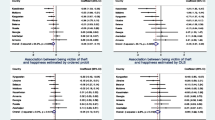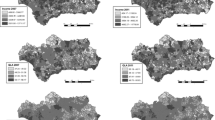Abstract
This article investigates the relationship between crime and quality of life in Saskatoon, Canada. The city has one of the highest crime rates in the country and has been referred to as the ‘Crime Capital of Canada’, a label that comes as a surprise to many residents and causes considerable concern among others. The aim of this research is to penetrate beyond sensational news headlines and bald crime statistics. The paper evaluates how perceptions of crime and safety affect the quality of life of residents living in neighbourhoods of different socio-economic status and geographic location. Both quantitative and qualitative time series data is analyzed in a sample of neighbourhoods over the period 2001–2004–2007. The findings of the data analysis are interpreted with respect to issues relating to the fear of crime, avoidance behaviour, risk minimization, social cohesion and community building.







Similar content being viewed by others
References
Andresen, M. A., & Brantingham, P. J. (2007). Hot spots of crime in Vancouver and their relationship with population characteristics. Ottawa: Department of Justice Canada.
Bannister, J., & Fyfe, N. (2001). Introduction: Fear and the city. Urban Studies, 38(5–6), 807–813.
Berg, B. L. (1995). Qualitative research methods for the social sciences. Boston: Allyn and Bacon.
Buck, K. (2008). Our fear of crime masks the reality. Regeneration and Renewal, 15, 16. February.
Canadian Policy Research Networks, CPRN. (2001). Indicators of quality of life in Canada: A citizens’ prototype. Ottawa: Canadian Policy Research Networks.
Canada Mortgage and Housing Corporation, CMHC. (1996). Quality of life indicators: A pilot test of the community oriented model of the lived environment. Ottawa: CMHC.
Carvalho, I., & Lewis, D. (2003). Beyond community: Reactions to crime and disorder among inner city residents. Criminology, 41(3), 779–812.
Community-University Institute for Social Research, CUISR. (2006). Quality of life in Saskatoon, SK: Achieving a healthy, sustainable community. Summary of research. Saskatoon: CUISR.
Community-University Institute for Social Research, CUISR. (2007). Tracking quality of life in Saskatoon/briefing paper. Saskatoon: CUISR.
Community-University Institute for Social Research, CUISR. (2008). Tracking quality of life in Saskatoon Saskatoon: Research Summary. Saskatoon: CUISR.
Dolan, P., & Peasgood, T. (2007). Estimating the economic and social costs of the fear of crime. British Journal of Criminology, 47, 121–132.
Doran, B. J., & Lees, B. G. (2005). Investigating the spatiotemporal links between disorder, crime, and the fear of crime. The Professional Geographer, 57(1), 1–12.
Farrall, S., Gray, E., & Jackson, J. (2007). Theorising the fear of crime: The cultural and social significance of insecurities about crime. Experience and expression in the fear of crime. Working paper no. 5. http://ssrn.com/abstract=1012393.
Federation of Canadian Municipalities, FCM. (2003). Falling behind: Our growing income gap. Ottawa: Federation of Canadian Municipalities.
Federation of Canadian Municipalities, FCM. (2005). Quality of life in Canadian cities. Ottawa: Federation of Canadian Municipalities.
Fitzgerald, R., Wisener, M., & Savoie, J. (2004). Neighbourhood characteristics and the distribution of crime in Winnipeg. Crime and Justice Research Paper Series. Ottawa: Canadian Centre for Justice Statistics.
Flick, U. (1999). An introduction to qualitative research. London: Sage Publications.
Franzini, L., O’Brien Caughy, M., Murray Nettles, S., & O’Campo, P. (2007). Perceptions of disorder: Contributions of neighbourhood characteristics to subjective perceptions of disorder. Journal of Environmental Psychology, 28, 83–93.
GSS. (1999). Statistics Canada. General Social Survey. Ottawa.
GSS. (2004). Statistics Canada. General Social Survey. Ottawa.
Hart Environmental Data. (1998). Sustainable community indicators: Trainers’ workshop. Hart Environmental Data. Online resource: (http://www.subjectmatters.com/indicators/).
Home Office. (2007). Crime in England and Wales 2006/07: A summary of the main figures. (www.homeoffice.gov.uk/rds/pdfs07/crime0607summ.pdf).
Jackson, J. (2004). Experience and expression: Social and cultural significance in the fear of crime. British Journal of Criminology, 44, 946–966.
Jackson, J. (2006). Introducing fear of crime to risk research. Risk Analysis, 26(1), 253–264.
Kitchen, P. (2006). Exploring the link between crime and socio-economic status in Ottawa and Saskatoon: A small-area geographical analysis. Department of Justice Canada Research and Statistics Division Methodological Series.
Liska, A. E., & Baccaglini, W. (1990). Feeling safe by comparison: Crime in the newspapers. Social Problems, 37(3), 360–374.
Liska, A. E., Lawrence, J. L., & Sanchirico, A. (1982). Fear of crime as a social fact. Social Forces, 60(3), 760–770.
Liska, A. E., Logan, J. R., & Bellair, P. E. (1998). Race and violent crime in the suburbs. American Sociological Review, 63, 27–38. February.
Liska, A. E., Sanchirico, A., & Reed, M. D. (1988). Fear of crime and constrained behaviour: Specifying and estimating a reciprocal effects model. Social Forces, 66(3), 827–837.
Maclean’s, (2008). The most dangerous cities in Canada. March, 24, 38–46.
Michalos, A. C., & Zumbo, B. D. (2000). Criminal victimization and the quality of life. Social Indicators Research, 50, 245–295.
Moller, V. (2005). Resilient or resigned? Criminal victimization and quality of life in South Africa. Social Indicators Research, 72, 263–317.
Muhajarine, N., Labonte, R., Williams, A., & Randall, J. (2008). Person, perception and place: What matters to health and quality of life. Social Indicators Research, 85(1), 53–80.
Randall, J. E., & Morton, P. H. (2003). Quality of life in Saskatoon 1991 and 1996: A geographical perspective. Urban Geography, 24(8), 691–722.
Sampson, R. J., & Raudenbush, S. W. (2004). Seeing disorder: Neighbourhood stigma and the social construction of “broken windows”. Social Psychology Quarterly, 67(4), 319–342.
Savoie, J. (2008). Neighbourhood characteristics and the distribution of crime: Edmonton, Halifax and Thunder Bay. Crime and Justice Research Paper Series. Ottawa: Canadian Centre for Justice Statistics.
Savoie, J., Bédard, F., & Collins, K. (2006). Neighbourhood characteristics and the distribution of crime on the Island of Montréal. Crime and Justice Research Paper Series. Ottawa: Canadian Centre for Justice Statistics.
Stafford, M., Chandola, T., & Marmot, M. (2007). Association between the fear of crime and mental health and physical functioning. American Journal of Public Health, 97(11), 2076–2081.
Thraves, B. D. (2007). Urban geography. In B. D. Thraves, M. L. Lewry, J. E. Dale & H. Schlichtmann (Eds.), Saskatchewan: Geographic perspectives (pp. 293–334). Regina: Canadian Plains Research Center.
Vanderveen, G. (2006). Interpreting fear, crime, risk and unsafety. BJU Legal Publishers.
Wallace, M., Wisener, M., & Collins, K. (2006). Neighbourhood characteristics and the distribution of crime in Regina. Crime and Justice Research Paper Series. Ottawa: Canadian Centre for Justice Statistics.
Whitzman, C. (2007). Stuck at the front door: gender, fear of crime and the challenge of creating safer space. Environment and Planning A, 39, 2715–2732.
Author information
Authors and Affiliations
Corresponding author
Rights and permissions
About this article
Cite this article
Kitchen, P., Williams, A. Quality of Life and Perceptions of Crime in Saskatoon, Canada. Soc Indic Res 95, 33–61 (2010). https://doi.org/10.1007/s11205-009-9449-2
Received:
Accepted:
Published:
Issue Date:
DOI: https://doi.org/10.1007/s11205-009-9449-2




